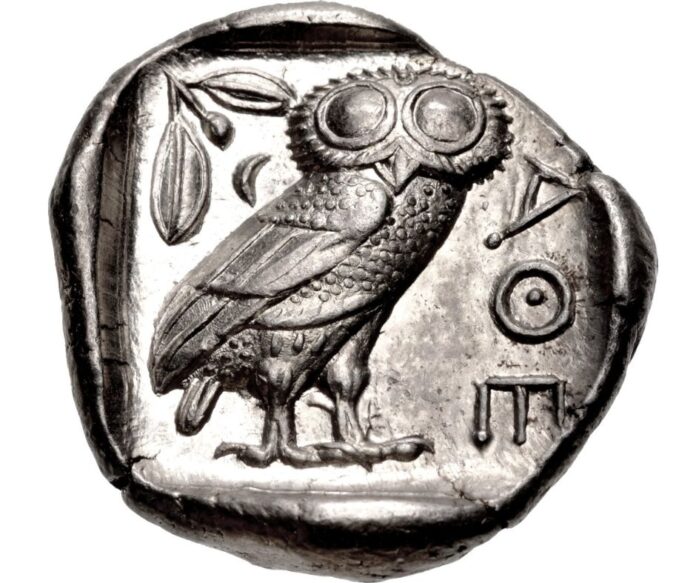
In the late 6th century B.C., the tetradrachm emerged as a large silver coin that became popular among the city-states of Greece. It represented four drachmae, and over time would become known as the standard coin throughout the ancient world. Its large size of roughly 25 mm rendered it a perfect advertising device for rulers of this period and would become widely used even beyond the known borders of the Greek world. It was minted in various quantities, although it’s believed that the weight standard derived in Athens of about 17.2 grams was widely accepted as the standard weight throughout the region.
Here’s a look at some of the more popular tetradrachms among collectors including examples from Athens, Rhodes, Akragas, Syracuse and Amphipolis.
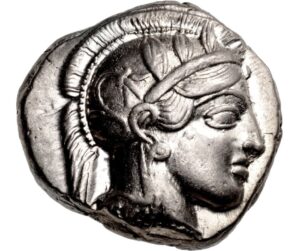
Athens
In the 6th century B.C., Athens began producing one of the first coins in the Greek mainland. Their most recognizable type is the tetradrachm often referred to as the “Athenian Owl,” which was first introduced around 510 B.C. Although the style would evolve over time, this coin was issued for over 400 years. It was minted in Athens and carries a number of motifs symbolic of the city. On the obverse is the head of Athena, the patron goddess of Athens. The reverse shows an owl and a sprig of olive. On the right of the owl are the first three letters of Athens in Greek: A?E.
An Athenian tetradrachm can be obtained today for a modest price based on their continuous run and large quantities minted. A quick search of the coin dealers’ site Vcoins.com reveals over 300 examples for sale which range from $400 to $4,000 depending on condition.
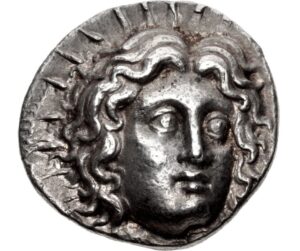
Rhodes
In the heart of the Mediterranean was the city of Rhodes, formed in 408 B.C. through the merger of three cities: Ialyssos, Kamiros and Lindos. The city would prosper for three centuries based on its key location within Mediterranean trade routes. A popular coin type struck by Rhodes was the silver tetradrachm revealing the patron sun god Helios on the obverse and a rose on the reverse. The historian Siculus explained that Helios saved the island from a disastrous flood and named the city after the nymph Rhodos.
Research on rarity and value at Vcoins.com reveals over 200 examples for sale which range from $200 to $3,000 depending on condition.
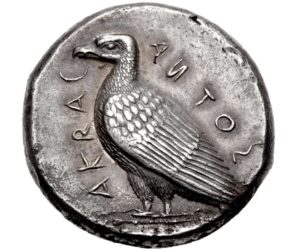
Akragas
Next, we shift to the island of Sicily, whose major city-states became well known for producing highly artistic examples of tetradrachms during the fifth century B.C. Among these was Akragas (modern-day Agrigento), a city built by the citizens of nearby Gela in 580 B.C. The city was ruled by an oligarchic government and saw a succession of tyrants in power. Under Theron, the third of these tyrants who came to power in 488 B.C., Akragas reached its political and military peak marked by the defeat of the Carthaginians in 480 B.C.
The Akragas silver tetradrachm shows an eagle, standing in profile to the left. On the reverse of the coin, a naturalistically rendered crab is shown with its claws extended and eight legs carefully articulated. The shell of the crab additionally has what appears to be a face on its back, possibly representing the eponymous city god “Akragas.”
The fresh-water river crab was employed on the coins of the city of Akragas as the city’s symbol to show the city’s dominance over land and sea. The eagle and the crab were both important symbols for Akragas. Later 5th century B.C. coins of the city often had more elaborate depictions of the animals.
The Akragas tetradrachm proves to be a rare tetradrachm for collectors to obtain in good condition. Vcoins currently only has a few examples listed for about $2,000 each.
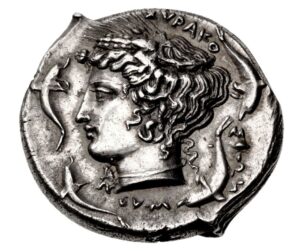
Syracuse
During the 5th century B.C., Sicily was in turmoil as several city-states pushed for control of the island. This pressure for control led to the establishment of tyrannical governments such as Hippocrates of Gela and his son Gelon. They founded a strong tyranny in Syracuse by 485 B.C.
The continuous warfare throughout the island required exorbitant amounts of money to hire mercenaries and finance their cultural movements.
It is believed that Syracuse had the first formal school for coin engraving and spared no expense to hire the most talented artists to operate the school. Famous engravers began to sign their works such as Euthydemus, Euainetos and Herakleidas. These masters developed new ways of viewing the world through art, breaking the rigid forms of Classic art and developing new methods of portraying motion and life on coinage. The silver tetradrachm was the preferred mode of expression, being large enough to display detailed images and also being minted in vast quantities.
A superb example is Nike, the goddess of victory, seen flying to the left crowning the charioteer with a wreath. The reverse displays an exquisite rendition of Arethusa, a nymph of a sacred spring within the colony.
Tetradrachms of Syracuse can be some of the more expensive examples to obtain. Vcoins currently displays about 50 examples, with worn examples starting around $1,000 and quickly rising to $15,000 or more for a very fine coin.
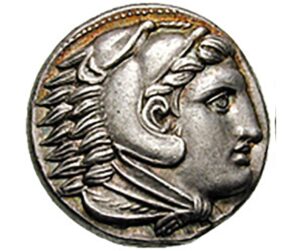
Amphipolis
The tetradrachms of Alexander the Great were minted in vast quantities to fund his numerous military expeditions in the 4th century B.C. The eventual conquest of Greece by the Macedonian King Philip II and his son Alexander the Great would bring a close to the Classical period, and usher in a new era called the Hellenistic period by Alexander’s death in 323 B.C. Alexander would issue an extensive series of coinage during his reign, including a tetradrachm depicting Herakles on the obverse. The use of Herakles refers to the lineage of Alexander who claimed that his family had descended from the famed hero. The reverse depicts Zeus, the revered king of all gods and men in Greek mythology.
The tetradrachms of Alexander the Great are easy to obtain at a modest price. Vcoins has over 400 examples currently for sale, ranging from $200 for good examples to $4,000 in very fine condition.
Overall, the silver Tetradrachm provides collectors with a beautiful hand-struck coin that exemplifies fine art in the Classical and Hellenistic periods of Ancient Greece. The Romans even allowed many city-states to continue with their local coinage after they were conquered. The result is the continuation of the tetradrachm, which displayed a hybrid blend of local civic identity combined with a stamp of their Roman rulers. These hybrid examples show the Roman tolerance toward Greek identity and religion, in which they ultimately absorbed and adopted many of the Greek rituals into their own culture.
This article about Tetradrachm coins previously appeared in COINage magazine. To subscribe click here. Article by Timothy M. Ryan.












